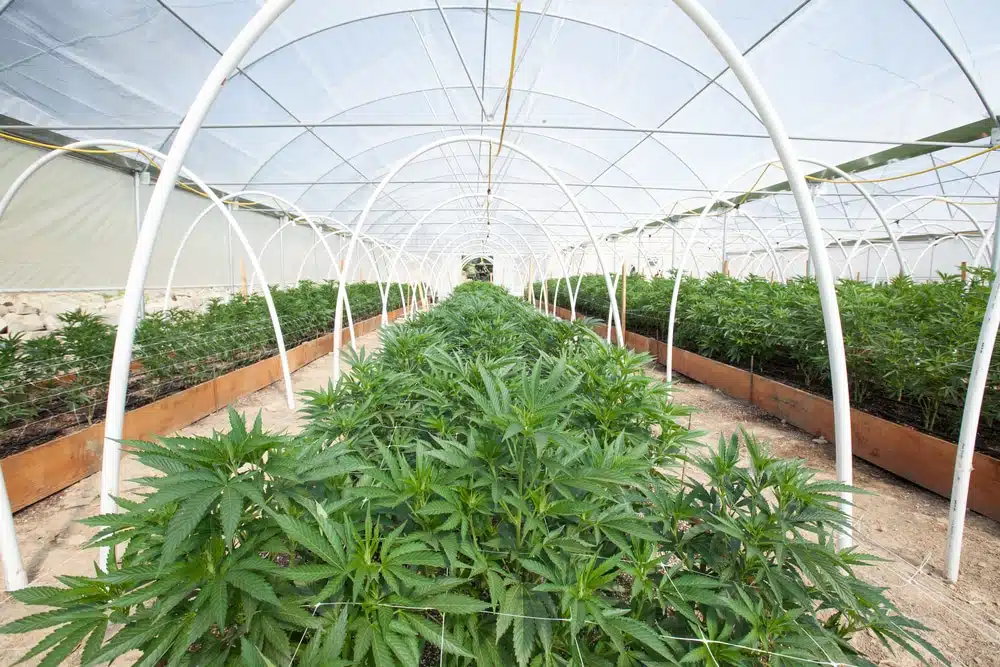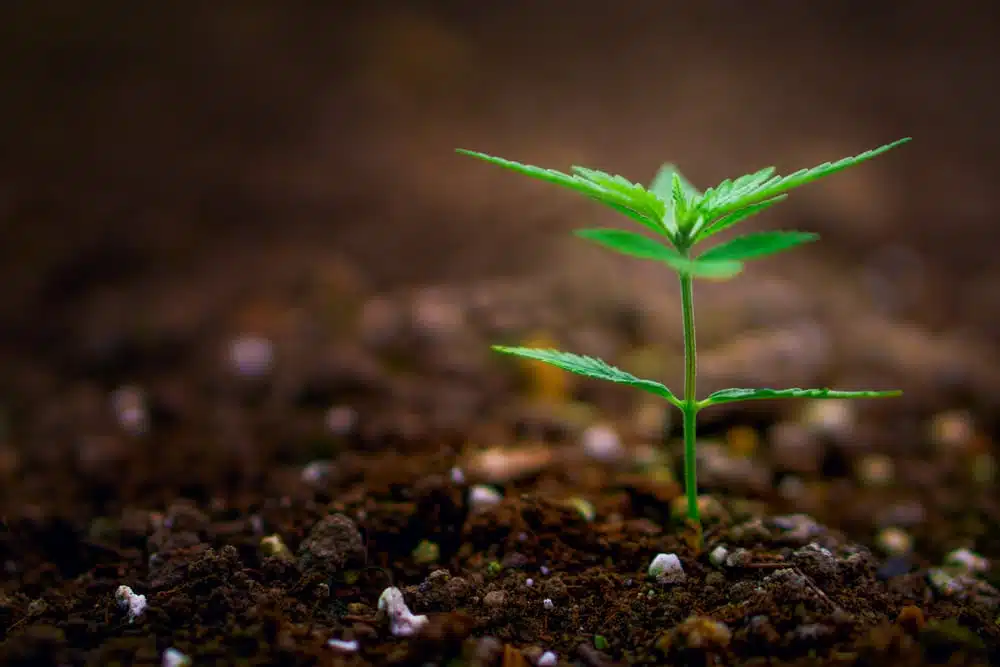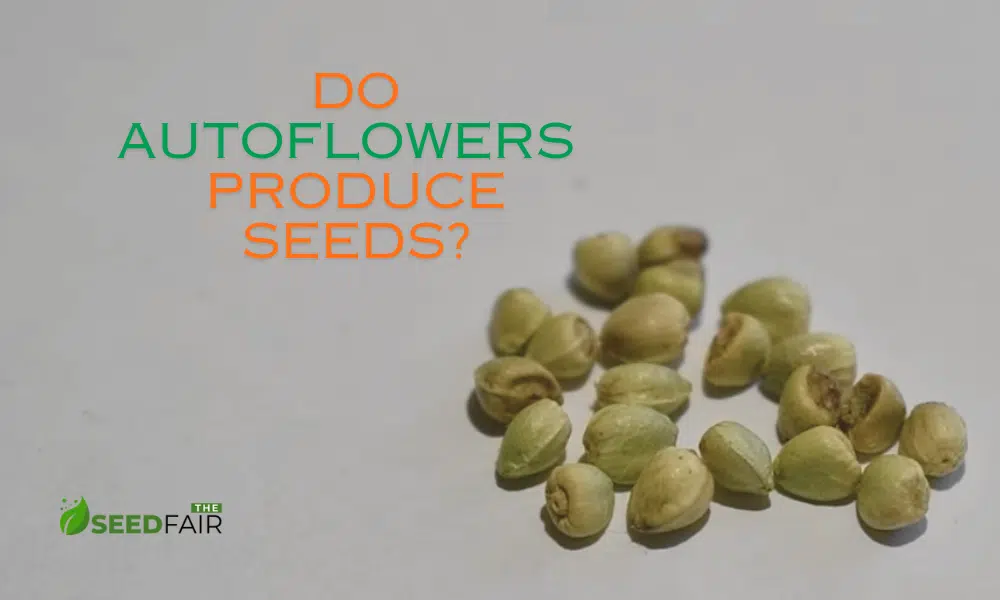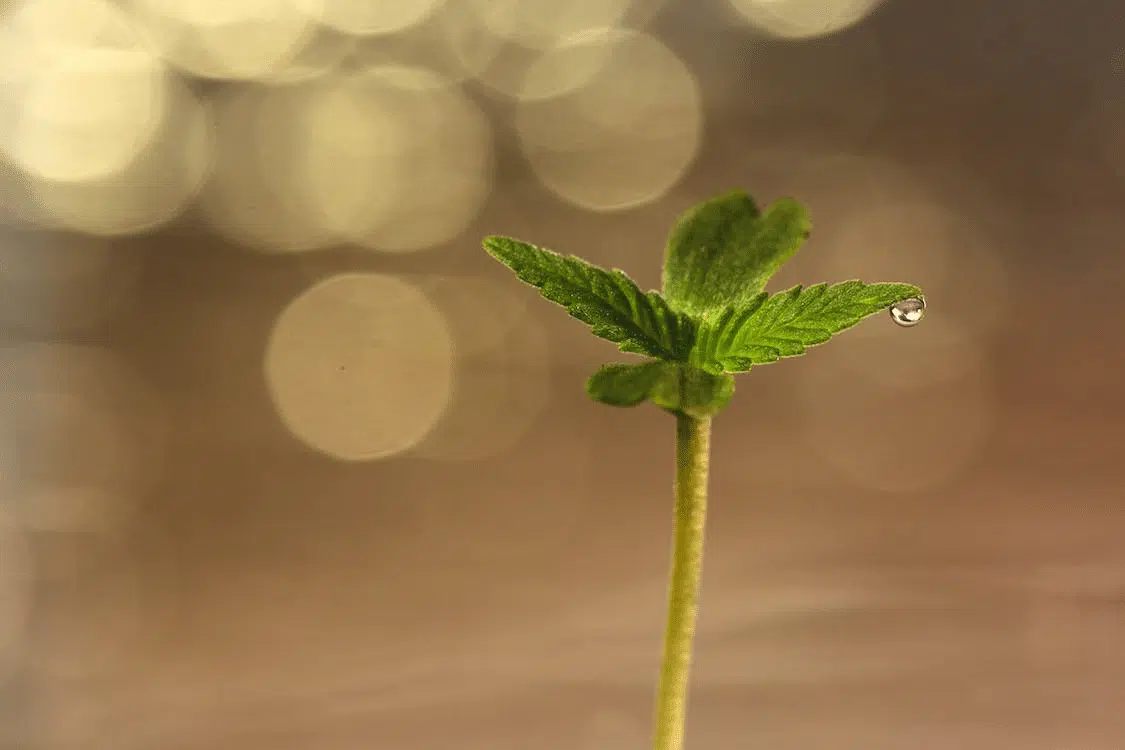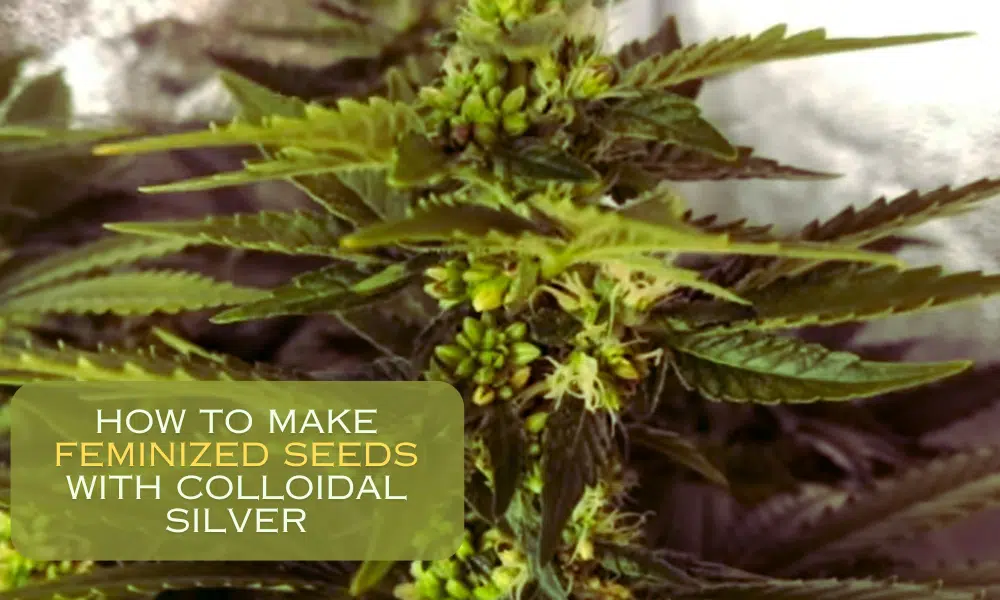Growing Marijuana in a Greenhouse
Growing cannabis in a greenhouse is an excellent idea. This method combines the benefits of indoor and outdoor growing.
Not sure where to begin? You’re in the right place.
Keep reading to discover the many advantages of greenhouse cultivation. Learn about the different types of greenhouse structures and how to construct them. Understand the process of marijuana greenhouse cultivation and identify the most suitable strains.
Let’s proceed.
Brief background on marijuana legalization
Colorado and Washington legalized the sale and recreational use of marijuana in 2012. Since then, 23 states, along with Guam and Washington, D.C., have followed suit. Many US regions also allow medical use.
Further proposals are ongoing in parts of the US that haven’t legalized cannabis. An April 2022 CBS News survey showed many Americans are in favor of 420-friendly laws.
Understanding cannabis as a plant
There are three main types of cannabis strains: indica, sativa, and ruderalis. Hybrids result from crossbreeding these cultivars. The category loosely determines the plant’s size, life span, and cannabinoid content, among other things.
Cannabis cultivars can be photoperiod or autoflowering. The former depends on light cycles to trigger blooming. The latter flowers automatically based on age.
Types of cannabis strains and their characteristics
Below is a brief description of the three main types of cannabis cultivars and their unique traits.
Cannabis sativa
Sativa cannabis plants come from hot and dry areas with plenty of natural sunlight and long days. These regions include Central America, Africa, Southeast Asia, and parts of Western Asia.
These crops typically grow tall, with some exceeding 12 feet. Sativa plants typically have a longer maturity period than indica crops.
Sativa-dominant strains usually offer a cerebral buzz and may reduce anxiety. They’re ideal for daytime use, making you feel productive and energized. These cultivars don’t have a sedating effect.
Cannabis indica
Indica cannabis plants originate in the Hindu Kush mountain range. They’re commonly found in Pakistan, Afghanistan, India, and Turkey.
These crops are short and sturdy with bushy foliage. Indica strains grow faster and produce denser nugs than sativa cultivars.
Indica-dominant cultivars typically deliver intense relaxation. These cultivars are said to relieve pain and nausea and improve appetite. Due to their potent sedative effects, it’s best to consume indica nugs at night.
Cannabis ruderalis
Ruderalis plants thrive in harsh conditions, originating in Eastern Europe, Siberia, and Russia. They develop fast to survive their growing environment. This genetic trait allows breeders to develop autoflower and fast version cannabis strains.
These plants are small and bushy, rarely exceeding 12 inches in height. Due to their fast development time, cannabis growers can typically harvest the nugs in about a month.
Ruderalis strains don’t offer much recreational or medicinal benefits due to their low potency. You can consume them at any time because there are minimal effects.
The life cycle of cannabis plants
All cannabis plants go through a life cycle that involves four specific stages. The duration of each phase may differ depending on the cultivar’s seed genetics.
Germination
Germination is a vital process where a weed seed develops its first roots and starts to grow into a seedling. There are various methods you can use to start your seeds and develop healthy plants. Most growers opt to complete this process indoors.
Cannabis seeds stay dormant until they’re exposed to water, oxygen, optimal temperature levels, and a high humidity range. Under these favorable conditions, the roots sprout.
Germination typically takes between 1–5 days.
Seedling stage
A cannabis plant enters this stage when its cotyledons sprout. It grows and reaches toward the light source for transpiration and photosynthesis.
More leaves form as the plant grows and its roots strengthen. Young plants are weak and susceptible to disease. Proper care is necessary to ensure they continue to develop. Ensure the container provides adequate drainage. Prevent moisture build-up to deter fungi, mold, and pathogens.
This life cycle phase lasts 2–3 weeks.
Vegetative stage
Cannabis crops build up nutrients during the veg stage to develop healthy nugs. Be vigilant to identify any deficiency signs and take remedial action immediately. Keep the humidity and temperature levels within the right range. Give your plants nitrogen-rich soil and enough water and nutrients.
Photoperiod plants rely on the right amount of illumination to start flowering and producing nugs. It’s possible to dictate the vegetative stage length if you’re growing cannabis inside a greenhouse. Most cultivators aim for 4–8 weeks, depending on the desired size. Give your plants an 18/6 schedule of light daily.
The vegetative stage lasts between 3–16 weeks.
Flowering stage
When growing outdoors, cannabis crops naturally flower when the days get shorter. Photoperiod plants produce buds when they get 10–12 hours of darkness daily. When using a greenhouse for cannabis, place a blackout plastic cover over it to stimulate this period. Autoflower crops flower when they mature, usually around 2–4 weeks after vegging.
During the flowering phase, your plants grow bigger and stronger. The branches need support to hold the developing dense colas. The nugs then form and fatten up. When the nugs ripen, it’s time to harvest.
Indica strains usually bloom in 8–10 weeks, while sativa cultivars flower for 10–12 weeks. Autoflower seeds typically go from seed to harvest in around 8–12 weeks.
The basics and benefits of growing marijuana in a greenhouse
A greenhouse allows you to grow cannabis in a controlled environment using a specially designed structure. The transparent material lets sunlight in while protecting your plants from unwanted critters. It also allows you to maintain optimal humidity and temperature levels.
Let’s look at the benefits of growing cannabis inside your greenhouse.
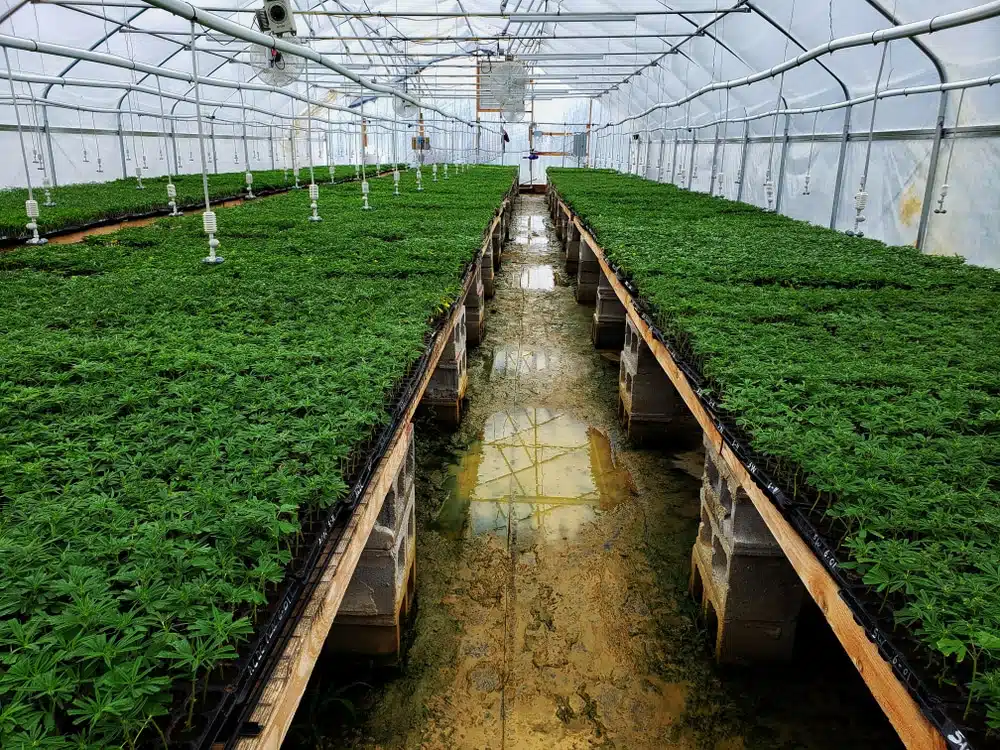
Benefits of cultivating marijuana in a greenhouse
As a greenhouse grower, you have more control over your plants and their growing conditions. Setting up a greenhouse takes time, money, and effort, but the following benefits make it worthwhile.
- You can dictate your plant’s life cycle. Control the light it receives to extend or shorten its vegetative stage and trigger flowering.
- Your plants have protection from the elements while using natural light to develop.
- You save on energy costs from using fewer grow lights.
- The danger posed by pests and diseases is minimal due to the sheltered space.
- It’s easier to regulate the temperature and humidity and control the environment.
- A greenhouse offers stable growing conditions that improve yield quantity and quality.
- Growing in a greenhouse keeps your plants away from public view. The sealed structure prevents the odor from bothering your neighbors.
- With the proper setup, you can lock your greenhouse weed plants and prevent theft.
Necessary equipment for a cannabis greenhouse
There are three types of greenhouses:
- Lean-to: These structures are constructed against the house wall.
- Detached: These are standalone greenhouses.
- Furrow: These buildings have a common gutter which connects at the eave.
Let’s look at the additional equipment you need for your plants to grow in a greenhouse.
Environmental control systems
Environmental control systems regulate the humidity, temperature, lighting, and airflow. Cannabis crops need optimal conditions for healthy growth. The system includes controllers, sensors, and software. Automation is essential for effective management.
Irrigation systems
Automated watering systems save time. They also allow you to control the frequency and amount of liquid to dispense. The irrigation option you choose depends on your needs and budget.
Lighting equipment
Although greenhouses receive sunlight, supplemental artificial lighting may be necessary. LED bulbs are efficient and cost-saving. Set up controllers to automate the on and off process.
Finding the right location for your greenhouse
The proper location for your greenhouse should have the following features:
- Situate your greenhouse facing south so your plants get the most sunlight all year round.
- Keep your structure away from prying eyes to avoid the risk of complaints and theft.
- Put your greenhouse close to utilities so you don’t have to extend electricity cables and piping from the mains.
Depending on where you live, you may have to follow certain legal regulations when building a greenhouse.
Preparing to grow cannabis in a greenhouse
Preparing for planting requires planning when cultivating marijuana in a greenhouse. Consider these factors:
- Greenhouse size: The area determines how many plants a big or small greenhouse can accommodate.
- Strain type: Indica plants are generally bushier, while sativa crops are taller. These factors restrict the number of plants you can grow in a fixed space.
- Environment: Consider the equipment you need in your greenhouse to grow plants under optimal conditions.
- Soil type: Choose a suitable substrate based on your preferences.
Choosing your cannabis strain
The cannabis strain you choose depends on the number of plants your greenhouse can accommodate and the yields you desire. Indica plants are bushier and produce denser nugs than the tall, lanky sativa crops.
Growing photoperiod plants involves extra costs, as lighting influences their vegetative and flowering stages. Add lamps to supplement sunlight. Light-proofing your greenhouse is necessary to ensure total darkness to stimulate flowering.
Autoflowers are ideal, as they don’t rely on light cycles. Their shorter life span means you can enjoy many harvests per growing season.
Some of the most popular strains to grow in a greenhouse are:
Preparing the soil for planting
Top-quality soil is vital to successful cultivation. Choose an oxygen-rich substrate with organic matter, like worm castings and compost. Loamy soil is ideal, as it provides excellent drainage and moisture retention. Soil pH is critical. The optimal range is 5.0–7.0.
Germinating your cannabis seeds
We recommend starting your seeds in an indoor grow room to protect them from threats. Sprouting outdoors exposes them to harsh weather, mold, and troublesome insects. When the roots sprout, carefully transfer them to your greenhouse.
There are several ways to germinate weed seeds. You can’t go wrong if you follow the proper steps. Below are some popular techniques that are simple to put in place.
Paper towel method
This germination technique requires two plates, paper towels, and tweezers.
Place your cannabis seeds between two moist paper towels. Keep them an inch apart. Use the plates to sandwich the towels. This process retains the moisture your seeds need. Store them in a dark space.
The seeds typically take 1–5 days to sprout. Plant them when the roots are about 0.20 inches long. Be extra careful when handling the fragile young plants and use sterile tweezers.
Direct soil method
Germinating in soil is the way nature does it. It’s the perfect environment. The medium protects the delicate roots.
Use soil that drains well. Wet the substrate and insert the weed seeds about an inch deep. Cover the surface with clear plastic to see if the medium is moist. Poke holes to allow airflow. Although moisture is critical, avoid excessive water. It could stunt growth or kill the seeds.
Place the pot in a location where the temperature is 70–90°F. Remove the plastic when the seedlings appear. You can transplant them or leave them to grow in the container.
It’s vital to use the right soil type. Potting soil or seed starters are excellent options. Ensure the pH is between 6.0–7.0. Avoid nutrient-rich substrates, as they’re unsuitable for seedlings.
Water soaking method
H2O helps cell division and growth. This method is straightforward. Drop your marijuana seeds into a glass of water, then store it in a dark space. Ensure the temperature is 68–77°F. Transfer them to another medium when the roots are about 0.1 inch long.
Planting and caring for your cannabis plants
Always provide your plants with care when growing in a greenhouse. Apply the following tips to enjoy successful cultivation.
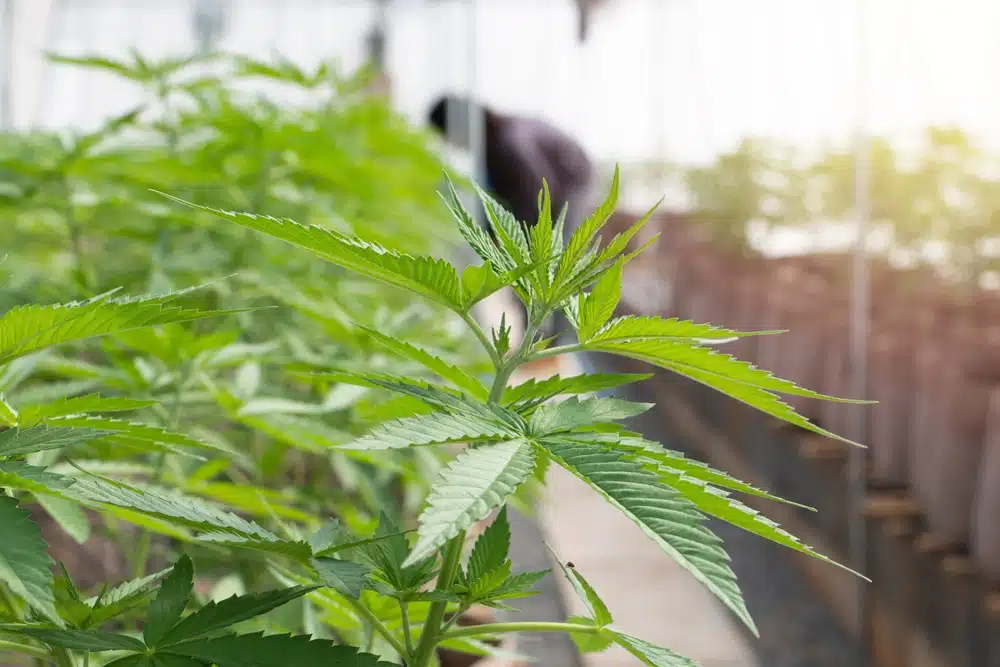
Transplanting your weed seedlings
Exercise extreme care when transplanting your seedlings to the greenhouse. Stress can damage your crops. Leave them in their new home for a few hours each day to acclimatize. Do this for a few weeks before the final move.
Maintaining an optimal environment in the greenhouse
It’s crucial to control various elements to maintain an optimal greenhouse environment.
Controlling temperature and humidity
Depending on your climate, your plants may need cooling and heating. Install a thermometer to check the temperature and adjust as needed. Proper ventilation prevents mold and mildew. Shutters and fans do an excellent job of facilitating airflow in your greenhouse.
Providing proper lighting
Growing in a greenhouse provides your plant with lots of sunlight, but you may need to install lamps if the lighting isn’t enough. Use LED bulbs, HPS lights, or MH grow lamps.
Watering and feeding your plants
Water and nutrients are vital for your plants to thrive. Be sure not to overwater or overfeed, as an excess may harm your crops.
Watering techniques and schedule
You may use the following watering methods:
- Water by hand
- Use a spray bottle
- Automated drip irrigation system
Hydrate your plants without drowning them in excess liquid. Consider the soil type, climate, and strain when preparing a watering schedule. There’s no one-size-fits-all solution.
Nutrient needs of marijuana plants
Using nutrient-rich soil provides your plants with the food they need. Add fertilizer when necessary. Be careful not to overfeed, as you may cause nute burn. Stay vigilant for signs of deficiency and remedy problems immediately.
Monitoring and preventing weed pests and diseases
Pests pose a risk to gardeners, including those growing in a greenhouse. An essential practice is regularly monitoring your cannabis crops.
Knowing how to identify an infestation allows you to treat your plants immediately. Organic solutions are best, but you can also use pesticides. Biological treatments like predatory insects also help. Prevention is ideal, but effective remedies can help your plants recover.
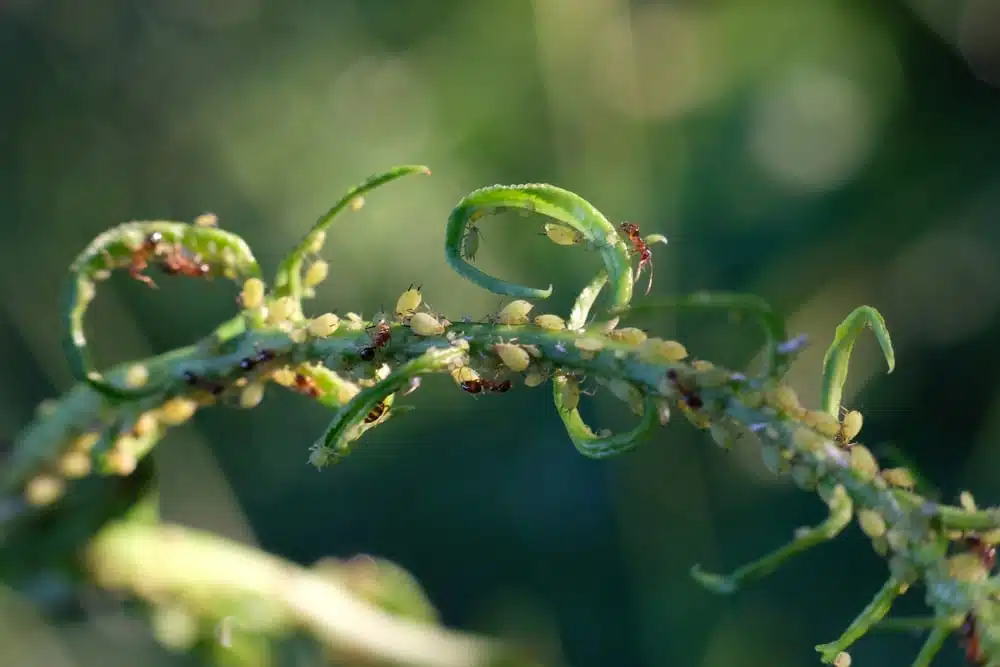
Common pests in marijuana cultivation
Greenhouse cannabis growers sometimes face bug issues. Some common insects that attack cannabis crops include:
- Spider mites
- Aphids
- Fungus gnats
Spider mites
The most common insects in your garden are spider mites. They live in colonies on the undersides of cannabis leaves. They look like tiny dots to the naked eye. Use a hand lens to view them.
What differentiates them from other insects is the webbing. Spider mites suck cell contents from plant foliage. A large population can cause severe damage. The plants usually recover after you remove the spider mites.
Aphids
Aphids are insects that suck fluids from your plants. Many species look similar. Their hues include green, black, red, and white.
You distinguish aphids from other insects by their cornicles, tube-like forms at the back of their bodies. Aphids also have long legs and antennae. Some have wings, but they’re generally wingless.
Aphids feed on leaves or stems in groups and can turn the foliage yellow. They can cause severe damage to your crops, as they transmit diseases.
Fungus gnats
Fungus gnats are flies that look like mosquitoes. They have slim legs and long antennae. These pests infest soil, compost, and other organic waste.
When growing in a greenhouse, be aware of fungus gnat larvae. Although they consume fungi and soil organic matter, they also chew roots. Damage can lead to stunted growth in young plants. Severe impairment can cause death.
Common diseases in weed plants
Knowing how to spot and treat cannabis diseases is essential. The two types of infections are fungal and bacterial. Three of the most common issues are:
- Root rot
- Powdery mildew
- Bud rot
Root rot
A pathogen infection can lead to root rot. Algae, fungi, bacteria, and parasites are some causes. The most likely culprit is Pythium. These fungi attack weak, damaged, or nutrient-deficient plant roots. Inspect underneath the plant to confirm the issue. Slimy brown roots are signs of a problem.
Other symptoms of root rot include:
- Foliage with burned edges
- Brown-spotted, yellowing leaves
- Old leaves falling off
- Stunted or abnormal growth
- Wilting
Overwatering creates damp conditions, ideal for fungi growth. Spores also thrive in hydroponic systems with warm temperatures.
Powdery mildew
Powdery mildew is one of the most common and tricky problems for growers. The disease infects leaves and sucks their cells. This effect reduces their photosynthesizing ability, leading to plant health issues.
The spores germinate in humid conditions. They spread fast and cause damage. Immature plants are most vulnerable. Powdery mildew may not affect your harvest if treated early.
Symptoms of an infection include proliferating white powder on the leaves. The damage becomes extensive when the blotches cover the plant and buds. Affected nugs are dangerous for consumption.
Bud rot
Bud rot results from a fungus, Botrytis cinerea, causing buds to rot inside. The pathogen spreads through water, air, animals, clones, and clothing.
It infects young, fragile stems and mature plants. Bud rot can cause plant death, as it sucks all the nutrients. It proliferates fast, so identifying the following signs early is vital:
- Buds with gray, black, or brown patches
- Dark brown and dry colas
- Yellowing leaves due to a lack of chlorophyll
Prevention and treatment strategies
Preventing an infection is the ideal strategy for growers. Ensure your cultivating conditions are unconducive for fungi and pathogens.
Feeding your plants with nutrients keeps them healthy and less vulnerable to attacks. Mix your soil with compost that produces good bacteria to fight parasites. Keep pests like fungus gnats away, as they may spread fungi.
Be vigilant to spot problem signs early. Prompt treatment often solves the issue before it can cause irreparable damage.
Harvesting and curing your marijuana plants
Harvesting is when you reap the fruits of your labor. This process involves more than just cutting off the buds.
Signs that your cannabis is ready for harvest
There are four visual signs that your cannabis is ready for harvest:
- The trichomes display an amber hue.
- Fan leaves turn yellow due to a lack of nitrogen.
- The leaves begin to curl and stop absorbing water when they mature.
- The pistils turn red or orange.
- Firm and tight nugs are a possible sign that they’re harvest-ready.
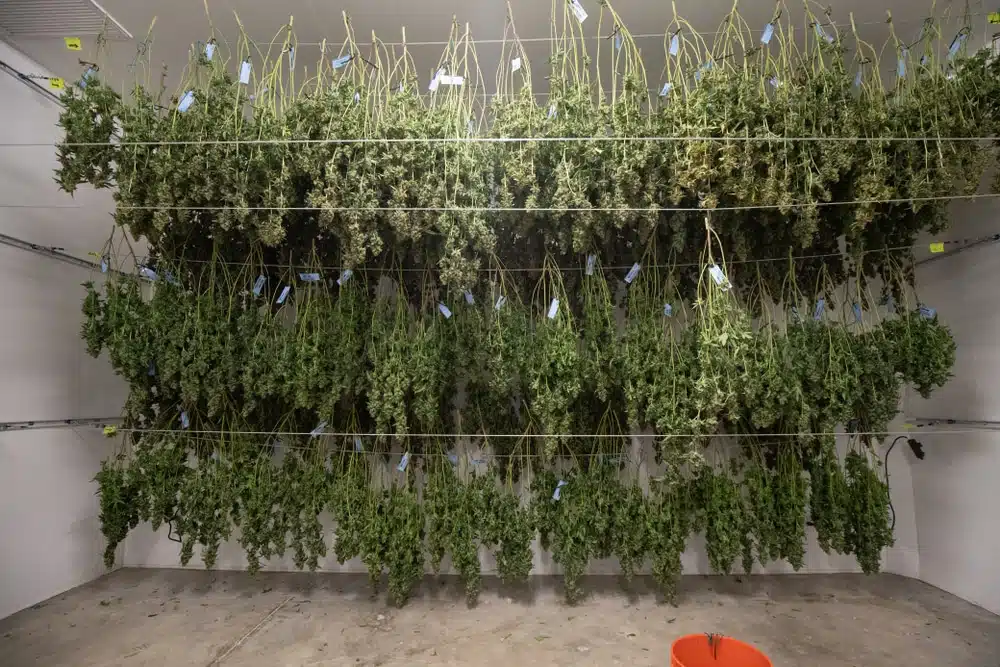
Harvesting techniques
To harvest cannabis, cut the branch at the plant’s base. Don’t pull it out, as it could damage the roots.
The importance of drying, curing, and proper storage
Don’t overlook the importance of drying and curing your buds. You could end up with undesirable nugs if you conduct these processes incorrectly.
Drying
Drying your nugs is vital, as wet buds may turn moldy. It also extends their freshness and boosts potency.
Use the following methods:
- Air-drying: This is the cheapest, easiest, and most risk-free technique. Avoiding contact with heat sources helps to prevent the buds from over-drying.
- Dehydrating: This method employs hot air to dry the buds fast.
- Using rotating fans: This option dries large amounts of nugs without expensive equipment.
Curing
Curing preserves the cannabis terpenes and cannabinoids. It also enhances bud aroma and flavor and may improve potency. Before storing your dry nugs, let them sit for a few weeks. This curing process prepares your buds for consumption.
Long-term storage
Store your dry buds away from light and heat. Airtight, opaque containers, like glass jars, are perfect. Don’t store them in the refrigerator, or they could become moldy. Place the jars in the freezer for long-term storage.
Legal considerations for greenhouse grows
Understand your state law on cultivation before growing in a greenhouse. There are restrictions even in areas where it’s legal. Staying on the right side of the law is vital. Ensure you follow your local legislation to enjoy the fruits of your labor.
Should you grow weed in a greenhouse?
Growing cannabis in a greenhouse is an excellent way to produce high-quality plants. This method combines the control of growing indoors with the perks of natural outdoor cannabis cultivation. By creating an optimal environment, you improve your chances of high yields. Knowing your plants are safe from external threats offers peace of mind.
Visit our blog for more cannabis cultivation tips.

